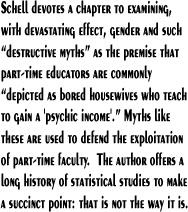2. I am consistently astounded by those few tenured full professors who subscribe to the view that part-time and full-time non-tenure-track faculty don't deserve academic freedom as manifested by tenure. It is even pathetic, and laughable, if it weren't so painful, to hear some who are protected by tenure make the global assertion that part-time and full-time non-tenure-track faculty don't want to be tenured. As if those who are exploited have a choice.
3. Is anyone surprised when academic administrators make the same arguments? They are worshiping at the altar of some amorphous deified concept of a corporate master. No matter that at a state university the public good is being sacrificed for a profit margin. To what end? So that some employees cannot expect a living wage nor exercise academic freedom? Not even the editorial pages of The Wall Street Journal, never ones to give the great unwashed a break, would reach to argue the former, yet, true to form; they do attempt to deflect blame for the exploitation of those others on tenure.
4. I've taken to thinking of late that academic administrators attend invitation-only administrator society meetings, learn of the newest techniques to increase that profit margin and get the all important “credit hours generated” at just the right point, then part company with a secret handshake. They all read the same professional journals advocating the latest trend in academic management, then implement something, anything, so they can cite their good works and glide effortlessly to their next job. Then, like locusts, they descend upon the unsuspecting, moving on to some other hapless victims once every shred and remembrance of its previous existence has been stripped from the institution.
5. The question we should ask is, “who does profit from this?” Charles Hammer observed, “[N]early all universities abuse the people they call part-timers ….Alas, we have no money to pay this poor teacher, or so the administrators tell us. But they know…[the part-timer] is a money machine.”
6. Some academic administrators will privately admit they advocate contingent faculty positions as a matter of economics and not for any pressing needs of institutional flexibility. Thus, this cheap and profitable labor is used to subsidize other things.
7. Indeed, the future of the professorate is not looking very good. Eileen Schell's book should be considered an important piece in the discursive puzzle which would help to illuminate the ongoing public discussion of academic employment, faculty status and compensation. While the title would seem to indicate a narrower focus, this work should be read by anyone interested in defining the present discourse and in defending the academy from its many detractors. Schell mixes previous scholarly research and statistics, cogent analysis, and compelling anecdotal evidence to paint a piercing view of contingent labor in the academy. Schell presents information and research in a logical progression, providing an informative introduction with following chapters addressing an historical background, gender, the realities of contingent writing instructors, transforming equity into reality, and finally, offering “imperfect solutions to imperfect problems.”
8. Schell devotes a chapter to examining, with devastating effect, gender and such “destructive myths” as the premise that part-time educators are commonly “depicted as bored housewives who teach to gain a 'psychic income'.” Myths like these are used to defend the exploitation of part-time faculty (39-51). The author offers a long history of statistical studies to make a succinct point: that is not the way it is.
9. And while it is true that Schell's discussion of writing instruction is a focal point of this book, does anyone in higher education still believe that this is the only discipline in which “contingent labor” is exploited? The description of the history, the philosophies and discussions, and the lessons learned would be valuable to anyone engaged in the subject of faculty status and compensation.
10. Schell's analysis of possible solutions is very clear. Ultimately as academics we must be involved in shaping the discussion, and we must insist on adherence to our view of the academy. “At the risk of sounding a note of democratic idealism, I conclude with a plea for academic citizenship, the idea that academic faculty are responsible for directing and changing the working conditions that both enable, define, and if we are not careful, constrain our ability to think, teach, and write” (p. 119).
11. The answer then, is for those who have the voice within the system, the faculty who are afforded academic freedom, to do the right thing. As Richard Moser observes, “[The current] multi-tiered approach [to faculty status] succeeded because it blunted opposition by promising not to affect existing constituencies. Yes, the evil genius of the multi-tier system is that it enticed tenured faculty with short-term benefits. We cooperated in our own demise. The good news about our complicity in this new system is that it depends on our complicity to continue. When we decide that having cheap labor on hand to teach our introductory courses or to provide inexpensive replacements for us while we conduct research is not worth risking the destruction of the university and our profession along with it, then the system will be reformed.”
12. If one accepts that tenure is academic
freedom, in an environment which exploits those who do not have such, what
does that say about the true nature of higher education? As Schell suggests,
“In the long run, refusal to address the issue of professional standards
and working conditions in our current climate of crises will hasten the
demise of academic freedom and tenure, and will jeopardize the future of
all workers in higher education.” (p. 121) The vibrancy of an academic
environment which gives faculty the ability and the obligation to present
the world of ideas with unfettered freedom will become a thing of the past.
The end result of such upon our students will be even more chilling.
They will only be able to avail themselves of training, not learning, and
will be inculcated into a culture where the value of critical thinking
is sacrificed on another altar of alleged employability.
Works Cited
Schell, Eileen E. (1998). Gypsy Academics and Mother-Teachers: Gender, Contingent Labor, and Writing Instruction. Plymouth, NH: Boynton/Cook.
AAUP. “Guidelines for Good Practice Part-Time and Non-Tenure-Track Faculty”. http://www.aaup.org/Issues/part-time/Ptguide.htm
AAUP (1993). “The Status of Non-Tenure-Track Faculty”. http://www.aaup.org/statements/Redbook/Rbnonten.htm
Ballard, Steven. “Committed to Fairness”. Kansas City Star, February 17, 2002, B7.
Finkin, Matthew W., ed. (1996). The Case for Tenure. Ithaca, NY: Cornell University.
Hammer, Charles. “Abusing Part-Timers”. Kansas City Star, February 17, 2002, B7.
Moser, Richard (2001). “The New Academic Labor System, Corporatization and The Renewal of Academic Citizenship”. http://www.aaup.org/Issues/part-time/cewmose.htm
Unsigned editorial. “Class Struggle: The Unionization of Grad Students”. The Wall Street Journal, March 22, 2002. http://www.opinionjournal.com/taste/
|
|

|
|

|
|
